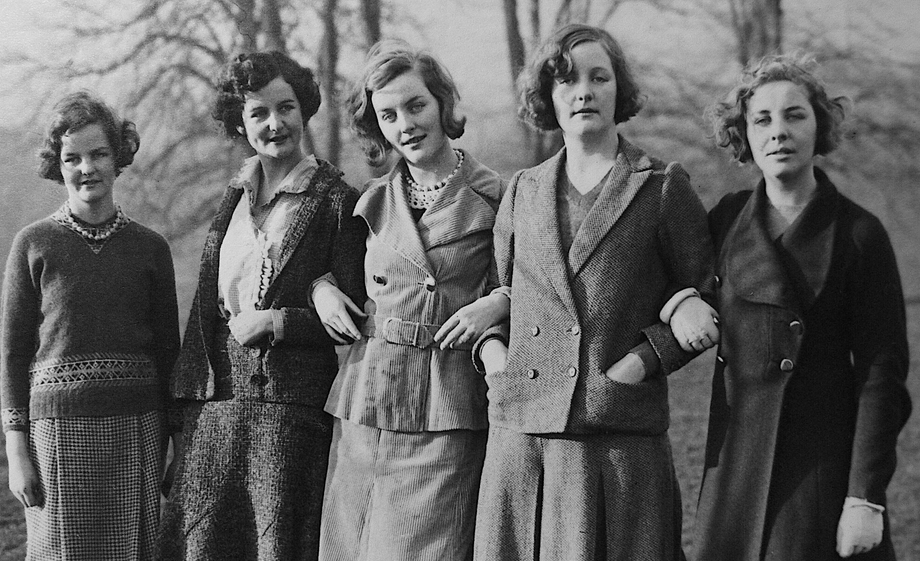
On December 10, 1945, Nancy Mitford — she is second from the left above — released The Pursuit of Love from the publishing house of Hamish Hamilton. This hilarious, high-spirited and sweepingly romantic tale came at just the right time to a country exhausted and numb after six years of war. Seventy-five years on, that spirit and the ingredients of love, childhood and the eccentricities of the English aristocracy make it still so eminently readable.
The novel opens with the arrival of cousin Fanny, the narrator, at Alconleigh, the country seat of her Uncle Matthew, Lord Alconleigh, his wife, Sadie, and their children. Fanny begins in elegiac mode, contemplating an old Radlett family photograph. “Click goes the camera and on goes life; the minutes, the days, the years, the decades, taking them further and further from the happiness and promise of youth.”
As many have found, it is almost impossible to separate the family from their fictional equivalents. The intensely autobiographical nature of Nancy’s fiction might suggest a lack of creative imagination but the real-life models on which she was so brilliantly able to draw – with some, but not much, embellishment – made it all the more fascinating for appearing to be true. The writer, Jane Smiley, observed, how modern was Nancy Mitford
The hallmark of Modernity was the recognition of the subjective — that a novelist’s (or an analysand’s, or a regular person’s) inner life shaped his or her sense of reality, and, in fact, was Reality … Nancy Mitford wasn’t the first English novelist to undermine her own reputation by over-sharing her personal life; when Anthony Trollope published his autobiography, he discussed money so relentlessly that he lost his audience for sixty or seventy years. But now the notorious Mitfords are fading into the past, and it is time for Nancy Mitford, the great novelist, to step forward.
And they were notorious. Nancy was the eldest of six extraordinary sisters: Pam, a Gloucestershire farmer; Diana, a beauty and British Fascist; Unity, a besotted Nazi; Jessica, a transplanted American communist; and Deborah, an English Duchess. Four of them became authors.
But in the early chapters of the novel, the sisters, like the Radletts, were still startlingly original, opinionated, uneducated. Their father, the second Lord Redesdale, became “Uncle Matthew”, a philistine given to building houses and blinding rages. Family folklore claimed he had only ever read one book, Jack London’s White Fang, and found it so good he felt no need to read another. It 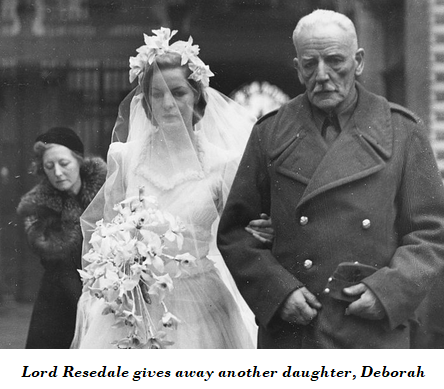 is now suspected he was dyslexic. In any case, his children read voraciously from their home’s huge library. While Alconleigh is portrayed as the Radlett seat from time immemorial and the elements of all country houses are there, but in the Mitfords’ case they had three Alconleighs. Nancy once wrote, “We lived under the shadows … of two hammers: that of the builder and that of the auctioneer.”
is now suspected he was dyslexic. In any case, his children read voraciously from their home’s huge library. While Alconleigh is portrayed as the Radlett seat from time immemorial and the elements of all country houses are there, but in the Mitfords’ case they had three Alconleighs. Nancy once wrote, “We lived under the shadows … of two hammers: that of the builder and that of the auctioneer.”
Uncle Matthew dominates the book. Affectionate, frightening, funny, endearing. “… he still remained for us as a sort of criterion of English manhood; there seemed something not quite right about any man who greatly differed from him.” Lord Redesdale (or ‘Farve’ as the girls called him) did not believe in school for gels (their one brother, Tom, was sent to Eton) so they remained cut orf at home; but he and their mother (‘Muv’) paid the price. While Nanny was a constant, a succession of fifteen governesses were frightened off with endless intricate teases, “shrieks” (of laughter), “floods” (of tears) and thirty-five nicknames ricocheting around the house. Out of this ‘ferocious intimacy’ the sisters hatched their own language and perfected a lifelong languid drawl and extravagant phrasing which became known as the ‘Mitford Voice’, which jumps off the pages of this novel.
Farve’s response to the novel was awaited with trepidation. Nancy wrote how he “sat with his nose in the book and grunted out various corrections: ‘never got the stockwhips in Canada, a bloke from Australia gave them to me’ and so on. He was delighted with it but cried at the end.” Nancy wrote to John Betjeman, relating that he said “he had read a sad book once before called Tess of the d’Urbervilles”. Lady Redesdale (‘Muv’) took little pleasure in Nancy’s triumph. She wrote to Jessica, “This family again. It’s about all of you as children, the heroine appears to be Debo, and you appear in it of course, and Farve and I.” As Nancy’s best biographer, Laura Thompson, puts it in Life in a Cold Climate (2015), “she had, after all, had a bellyful with Unity, Diana, and indeed Jessica. But nor was she overjoyed with her portrayal as Aunt Sadie, feeling as she did a small chill within it…”
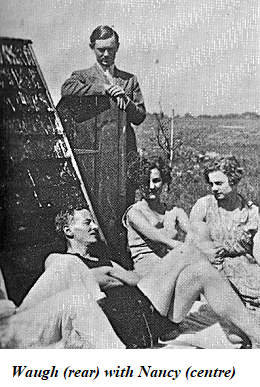 But decades later, the sisters seemed to be intensely fond of Pursuit. As Thompson says, “as if it, too, were a member of the family, which in a sense it was.” As Diana saw it, “in its way just about perfect. I can’t find a criticism. Evelyn couldn’t have done it.” Interestingly, Evelyn Waugh, Nancy’s great friend and correspondent, was a valued mentor and played a key part in Pursuit. Nancy had favoured the title My Cousin Linda and it was Waugh who suggested The Pursuit of Love. He had sent her an early copy of his masterpiece Brideshead Revisited, published in May 1945, and as she relayed their worldly friends’ views on the classic (she was well-informed, having created a salon at Heywood Hill’s bookshop in Mayfair), she confessed,
But decades later, the sisters seemed to be intensely fond of Pursuit. As Thompson says, “as if it, too, were a member of the family, which in a sense it was.” As Diana saw it, “in its way just about perfect. I can’t find a criticism. Evelyn couldn’t have done it.” Interestingly, Evelyn Waugh, Nancy’s great friend and correspondent, was a valued mentor and played a key part in Pursuit. Nancy had favoured the title My Cousin Linda and it was Waugh who suggested The Pursuit of Love. He had sent her an early copy of his masterpiece Brideshead Revisited, published in May 1945, and as she relayed their worldly friends’ views on the classic (she was well-informed, having created a salon at Heywood Hill’s bookshop in Mayfair), she confessed,
I am writing a book, also in the 1st person. (Only now has it occurred to me everybody will say what a copycat – never mind that won’t hurt you only me) It’s about my family, a very different cup of tea, not grand and far madder. Did I begin it before reading B.head or after I can’t remember….I’m awfully excited my fingers begin to itch.
Never would a book be so easy for her to write. It took her about three months, January to March 1945. She had been contemplating what she called ‘her autobiography’ since 1942. But the spark 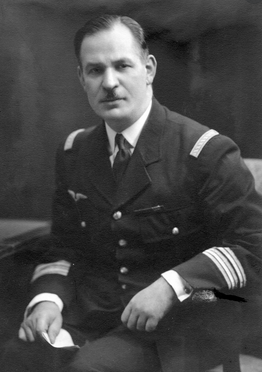 was her meeting with Gaston Palewski. The Parisienne son of a Jewish industrialist from Belarus, Palewski was Charles de Gaulle’s chef de cabinet and homme de confiance. He and Nancy met at the Allies Club in London in 1942 and Nancy fell irrevocably in love – with him, and with France. She would call him ‘Colonel’. He may have been short and stocky with a face like “an unpeeled King Edward” but he was a consummate saloniste and practised lover. A committed Anglophile, he had spent a post-graduate year at Oxford, and when Nancy met him he was already welcome in the drawing rooms of Ladies Colefax and Cunard. As he had in Paris: Proust had been a pal and those who inspired Marcel were also friends of Gaston (pictured at right in his wartime London exile). Within weeks of meeting they were lovers. In the novel she writes of that “sound more intimately connected with the urban love affair than any except the telephone bell, that of a stopping taxi cab. Sun, silence and happiness.”
was her meeting with Gaston Palewski. The Parisienne son of a Jewish industrialist from Belarus, Palewski was Charles de Gaulle’s chef de cabinet and homme de confiance. He and Nancy met at the Allies Club in London in 1942 and Nancy fell irrevocably in love – with him, and with France. She would call him ‘Colonel’. He may have been short and stocky with a face like “an unpeeled King Edward” but he was a consummate saloniste and practised lover. A committed Anglophile, he had spent a post-graduate year at Oxford, and when Nancy met him he was already welcome in the drawing rooms of Ladies Colefax and Cunard. As he had in Paris: Proust had been a pal and those who inspired Marcel were also friends of Gaston (pictured at right in his wartime London exile). Within weeks of meeting they were lovers. In the novel she writes of that “sound more intimately connected with the urban love affair than any except the telephone bell, that of a stopping taxi cab. Sun, silence and happiness.”
As another consummate biographer, Selina Hastings, put it,
it was as though falling in love had given her access to a creative source of which previously she had barely skimmed the surface. It is all here, all Nancy’s life, in this novel, exaggerated in parts, circumstances changed, fantasies fulfilled (Fabrice tell Linda he loves her), but as a testament of her heart and mind it is true to the last letter. The hero is, of course, Colonel as Fabrice, down to the smallest detail, from his demands to be entertained – ‘Alors, racontez!’
She was given to hero-worship; and well, he was the great love of her life but the saddest thing was 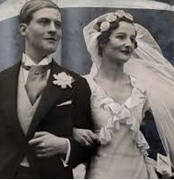 that when Nancy told her Colonel how she loved him, he would merely say, “I know.” Of course, as with the fictional Linda Radlett, the position was complicated (or as the French put it, ‘pas so simple’), as Nancy had earlier married (left) a fellow Hon, Peter Rodd, the third son of diplomat Lord Rennell of Rodd and his wife, Lilias, a model and inspiration for the mesmerisingly monstrous Lady Montdore in the sequel, Love in a Cold Climate. “Prod”, as the sisters came to call him, was handsome and clever but also a know-all, feckless, unfaithful and unemployable. Both Linda Radlett’s husbands, Tony Kroesig and Christian Talbot — a Tory with Nazi sympathies and an aristocratic Marxist — are milder composites of Prod. By 1940 all passion had been spent and Nancy and Peter tended to live separate lives but did not divorce until 1958.
that when Nancy told her Colonel how she loved him, he would merely say, “I know.” Of course, as with the fictional Linda Radlett, the position was complicated (or as the French put it, ‘pas so simple’), as Nancy had earlier married (left) a fellow Hon, Peter Rodd, the third son of diplomat Lord Rennell of Rodd and his wife, Lilias, a model and inspiration for the mesmerisingly monstrous Lady Montdore in the sequel, Love in a Cold Climate. “Prod”, as the sisters came to call him, was handsome and clever but also a know-all, feckless, unfaithful and unemployable. Both Linda Radlett’s husbands, Tony Kroesig and Christian Talbot — a Tory with Nazi sympathies and an aristocratic Marxist — are milder composites of Prod. By 1940 all passion had been spent and Nancy and Peter tended to live separate lives but did not divorce until 1958.
Laura Thompson and yet another biographer, Lisa Hilton (The Horror of Love), have suggested that “So long as she was married, she did not have to face the fact that Gaston wouldn’t have her even if she were free.” Could anyone really see Nancy Mitford as Mme Palewski. She was never going to be Yvonne de Gaulle. And yet, while childbirth and the Gestapo despatch Linda and Fabrice, Hilton observes that the novel was not “the fantasy of a disappointed mistress. At least when Nancy wrote Pursuit she did have her colonel, he had come back to her from the blue skies above Algeria, and she was preparing for a life with him in the city she loved best in the world.”
Nancy trumped her Pursuit success with Love in a Cold Climate four years later; again drawing on life with the Radletts, but focussing on their neighbours – Lady Montdore and Cedric Hampton, the very image of the narcissistic Bright Young Thing, Stephen Tennant. Although Nancy had killed off the Colonel, he reappeared as Charles-Edouard du Valhubert, a charming aristocratic womaniser, in her later, engaging but less successful fiction, The Blessing (1951), and Don’t Tell Alfred (1960). Nancy even slotted the real name of one of the colonel’s many mistresses into the narrative.
When she felt she had finished with fiction and turned to biography, the Colonel kept appearing – as Louis XV in Madame de Pompadour (1954) and Louis XIV in The Sun King (1966). There were even glimpses of him in Voltaire in Love (1957). Nancy’s non-fiction also proved popular. Again Waugh advised her on finding her voice and a readership when she turned to history — in this case Madame de Pompadour; “Write for the sort of reader who knows Louis XV furniture when she sees it but thinks Louis XV was the son of Louis XIV and had his head cut off.”
The family began to call Nancy the French Lady Writer. Suffused with her breathless, idiosyncratic style (the duc de Richelieu was “perfectly odious”; Pompadour found many French customs “too common for words”) her historical memoirs masked months of solid research; no mean feat for a gel who hadn’t been allowed to attend school. (Farve feared they’d come home with thick ankles from playing hockey.) As Laura Thompson notes, so strong and consistent is Nancy’s voice throughout her work that to snatch and read at random sentences from any of her books is “like looking at the six faces of the Mitford girls.”
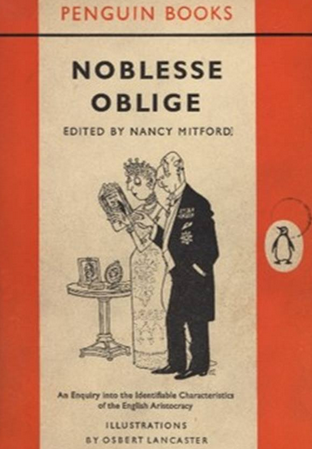 Another genre where she shone was her journalism (collected in A Talent to Annoy in 1986). Her regular pieces from Paris were essentially a string of teases, the most provocative of which was an article entitled “The English Aristocracy” (later part of a collection Noblesse Oblige in 1956) where she laid down the law on what was acceptable in upper-class speech, giving birth to the terms “U” and “Non-U”, the U standing for ‘upper class’.
Another genre where she shone was her journalism (collected in A Talent to Annoy in 1986). Her regular pieces from Paris were essentially a string of teases, the most provocative of which was an article entitled “The English Aristocracy” (later part of a collection Noblesse Oblige in 1956) where she laid down the law on what was acceptable in upper-class speech, giving birth to the terms “U” and “Non-U”, the U standing for ‘upper class’.
While Nancy quietly revised her early fiction, turning mantelpieces into chimneypieces, mirrors to looking glasses, and notepaper to writing paper, letters poured into the press. (“As a descendant of William the Conqueror, I agree with what she says”; “My secretary is so furious with you, she refused to type this letter”) Nancy soon tired of the controversy but enjoyed Osbert Lancaster’s cartoon of a white-tied gent at a ball, “I’m dancing with tears in my eyes ‘cos the girl in my arms isn’t U”. Such was her affection for Lancaster’s art that it would later grace the cover and pages of the first Penguin edition of Noblesse Oblige.
She also poured her genius into her correspondence. Two volumes, both edited by her niece Charlotte Mosley, Love from Nancy in 1993; her letters to and from Evelyn Waugh in 1996; and her post-war correspondence with Heywood Hill, The Bookshop at 10 Curzon Street in 2004 (edited by John Saumarez Smith). Her letters reveal Nancy at her witty, worldly, sharp-eyed, sharp-tongued best. And in 2007 came the thumping The Mitfords: Letters between Six Sisters, again beautifully edited by Charlotte Mosley.
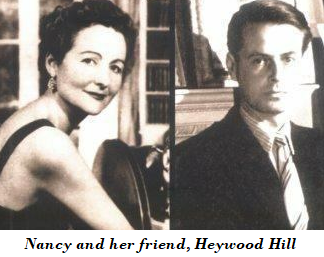
Nancy’s ability to shriek in the face of pain and loss never faltered, despite an agonising four-year battle with (then undiagnosed) Hodgkin’s disease and the Colonel’s marriage, in 1969, to a divorced protestant duchesse (having told Nancy for years that he could not marry a divorced protestant). She managed to finish Frederick the Great in 1970 and to write letters that sparkled and stung right up to the end.
In the Spring of 1972 she was given the Légion d’Honneur, which the Colonel pinned on her. She 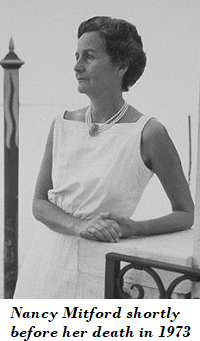 cried with happiness afterwards. And, as if the cross-Channel neighbours were competing, she was told she would be honoured with the CBE. At first, she pretended to never having heard of it but then warmed to the idea, “It enables me to sit above a knight’s widow so you must find me one to take everywhere with me (I do, anyway, without wishing to boast, as a peer’s daughter…’)
cried with happiness afterwards. And, as if the cross-Channel neighbours were competing, she was told she would be honoured with the CBE. At first, she pretended to never having heard of it but then warmed to the idea, “It enables me to sit above a knight’s widow so you must find me one to take everywhere with me (I do, anyway, without wishing to boast, as a peer’s daughter…’)
On June 30, 1973, the Colonel was driving on the outskirts of Versailles (where Nancy lived) and had a strong presentiment that he should go to her. He went straight upstairs, his spaniel running ahead as she always did. Nancy was apparently unconscious but she smiled as he took her hand. She died a few hours later; an ending as poignantly romantic as any she could have written and one that underlined the links between her life and her art.
A last word on the novel whose publication we celebrate; in fact the last lines of The Pursuit of Love, which reflect that unswerving knowingness of the author. When Fanny, says of the dead Linda, “But I think she would have been happy with Fabrice…He was the great love of her life, you know.” Her mother, the Bolter, observed, “Oh, dulling, one always thinks that. Every, every time.”
Mark McGinness, an Australian living in the United Arab Emirates, is a frequent contributor
 Sign In
Sign In 0 Items (
0 Items ( Search
Search









Farve read The Pursuit of Love?! That’s amazing.
Thank you for this article, Mark. Nancy Mitford has long been a tonic to me, and your article once again dispels the gloom of Monday morning, “If one can’t be clever, one should at least be amusing” is advice attributed to her, and a complete philosophy for life.
Now, more books to read. Thank you.
Jessica swallowed whole the leaden, humourless orthodoxies of the American Communist Party, but her output included sparkling journalism like ‘Let us now appraise famous writers’, in which she fatally skewered and eventually bankrupted the horrible racket that was the ‘Famous Writers’ School’. The most devastating piece of journalism I’ve ever read, it’s freely available at https://www.theatlantic.com/magazine/archive/1970/07/let-us-now-appraise-famous-writers/305319/